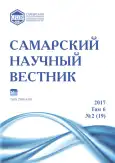Vegetation cover and small mammals as the components of biocoenosis in the conditions of the Volga Upland
- Authors: Boryakova E.E.1
-
Affiliations:
- Lobachevsky State University of Nizhni Novgorod
- Issue: Vol 6, No 2 (2017)
- Pages: 18-23
- Section: 03.02.00 – General Biology
- URL: https://journals.rcsi.science/2309-4370/article/view/21789
- DOI: https://doi.org/10.17816/snv201762103
- ID: 21789
Cite item
Full Text
Abstract
The study of the nature reserve «oak forest near the village of Pelya-Khovanskaya» ecosystem was done in the region of Nizhny Novgorod. The investigated wood is unique for its complex structure. It is situated in the forest-steppe zone, characterized by a high species diversity of small mammals and vegetation, which indicates the complexity of trophic and spatial connections. Several series of sample plots were described: 41 of 20×20 m and a number of 1×1 m sites, totaling 300. Abundance of species by Brown-Blanke scale and the number of specimens of adolescence were specified for each 1 sq. m. plot. Mammals were trapped with the help of trapping grooves and transects method. Vegetation cover is characterized by the presence of a clear intra-differentiation as well as the existence of two basic ecologo-coenotic groups/cores - the nemoral (with Pulmonaria obscura Dum. as the center species of the core) and the meadow-fringe. The most distinct group is formed by forest-shoot species. It can be explained by more forest-steppe rather than nemoral nature of vegetation. Small mammals are represented by the following species: common and small shrews, small forest mouse, yellow-throated and field mice and harvest mouse, vole-housekeeper, common, plowed and red voles, European mole. Two species among them - vole-housekeeper and mouse-baby - are listed in the Red Book of the Nizhny Novgorod Region. Matching burrows of mouse-like rodents with soil richness with nitrogen and humidity, two well-defined peaks are observed. The greatest number of burrows is found in places where the soil is high in nitrogen. Moles were found in areas with a large projective coating of Primula veris: coefficient Spearman rank 0,50. There was a negative correlation of the number of moles and vegetation covering of Pyrethrum corymbosum (-0,46), which is the marker of the driest parts in the forest. In general, the nature reserve «oak forest near the village of Pelya-Khovanskaya» is of considerable interest, both from botanical and from zoological point of view. Long-term studies of biocoenosis will allow to monitor the facility and to correct the proposed protective measures.
Full Text
##article.viewOnOriginalSite##About the authors
Elena Evgenievna Boryakova
Lobachevsky State University of Nizhni Novgorod
Author for correspondence.
Email: boryakova@mail.ru
candidate of biological sciences, associate professor of Botany and Zoology Department
Russian FederationReferences
- Борякова Е.Е., Лямина Н.С. Пространственная структура сообществ мелких млекопитающих и ее связь с фитоценозом // Вестник Оренбургского государственного университета. 2013. № 6 (155). С. 138-142.
- Борякова Е.Е. Связь пространственной структуры сообществ мелких млекопитающих и растительного покрова как компонентов биоценоза // Динамика систем, механизмов и машин. 2014. № 6. С. 77-79.
- Борякова Е.Е. Характер растительного покрова и распределение мелких млекопитающих в условиях Нижегородского Предволжья // Изучение, сохранение и восстановление естественных ландшафтов. Волгоград: Волгоградское научное издательство. 2014. С. 108-116.
- Воротников В.П., Боряков И.В., Борякова Е.Е., Краснобаева О.С. О корреляционной структуре сообществ и инфраценотической организации широколиственных лесов юга Нижегородской области (на примере дубрав Починковского района) // Лесоэкологические проблемы Поволжья. Н. Новгород. 2003. С. 71-79.
- Boryakova E.E., Melynik S.A., Sizova O.N. Vegetazione e distribuzione di piccolo mammiferi in Nizhny Novgorod Prima il fiume Volga (Predvolzhye) // Italian Academik and Scientific Journal. 2014. № 3 (12). P. 251-255.
- Boryakova E.E., Vorotnikov V.P., Melynik S.A. Ecological Distribution of the Pygmy Filed Mouse (Apodemus uralensis) and Niche Differentiation in Micromammalia Communities of Conifer-Deciduous Forests of the Volga Upland // The 3d the International Conference on Recent Trends in Science and Technology Management. London: SCIEURO, Berforts Information Press Ltd, UK. 2015. P. 38-48.
- Кашкаров Д.Н. Основы экологии животных. Л.: Учпедгиз, 1945. 384 с.
- Виноградов Б.С., Громов И.М. Грызуны фауны СССР. М.-Л.: Изд-во академии наук СССР, 1952. 296 с.
- Башенина Н.В. Пути адаптаций мышевидных грызунов. М.: Наука. 1977. 355 с.
- Жигарев И.А. Локальная плотность и индивидуальные участки рыжей полёвки в условиях южного Подмосковья // Зоологический журнал. 2005. № 84 (6). С. 719-727.
- Ellenberg H., Weber H., Düll R., Wirth W., Werner W., Paulißen D. Zeigerwerte von Pflanzen in Mitteleuropa // 2nd ed. Scr. Geobot. 1992. V. 18. P. 1-258.
- Карасева Е.В., Телицина А.Ю. Методы изучения грызунов в полевых условиях. М.: Наука, 1996. 226 с.
- Боряков И.В., Воротников В.П., Борякова Е.Е. Использование информационных технологий для организации фитоценариев и обработки геоботанических данных // Ботанический журнал. 2005. № 90 (1). С. 95-104.
- Гланц С. Медико-биологическая статистика. М.: Практика, 1999. 334 с.
- King K.L., Homyack J.A., Wigley T.B. et al. Response of rodent community structure and population demographics to intercropping switchgrass within loblolly pine plantations in a forest-dominated landscape // Biomass and Bioenergy. 2014. V. 69. P. 255-264.
- Larsen A.L., Homyack J.A., Wigley T.B. et al. Effects of habitat modification on cotton rat population dynamics and rodent community structure // Forest Ecology and Management. 2016. Vol. 376. P. 238-246.
- Соловей И.А. Ландшафтные особенности структуры ассоциаций мелких млекопитающих в хвойно-мелколистввенных комплексах северной Беларуси // Териофауна России и сопредельных территорий: мат-лы междунар. совещания VII Съезда Териологического общества при РАН. М.: Товарищество научных изданий КМК, 2003. С. 335.
- Zhong W., Wang G., Zhou Q. et al. Spatial niche partitioning of coexisting small mammals in sand dunes // Italian Journ. of Zoology. 2016. V. 83, № 2. P. 248-254.
- Porter W., Sabo J., Tracy C. et al. Physiology on a Landscape Scale: Plant-Animal Interactions // Integrative and Comparative Biology. 2002. V. 42(3). P. 431-453.
- Root J., Calisher C., Beaty B. Relationships of deer mouse movement, vegetative structure, and prevalence of infection with Sin Nombre virus // Journal of Wildlife Diseases. 1999. V. 35(2). P. 311-318.
Supplementary files








